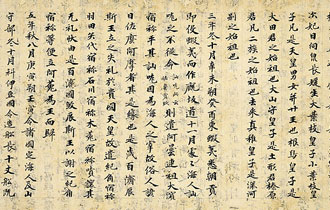Postwar Period (1945 – Present)
After the Allied occupation was officially ended with the San Francisco Peace Treaty on September 8, 1951, and Japan became once again an independent state when the treaty went into effect on April 28, 1952, the nation set about rebuilding itself from the devastation of war. Now, however, it was under a new governing arrangement in which the emperor’s prerogatives were severely curtailed, and decision-making fell to the de jure independent Diet. Despite the Allies’ relinquishment of control, Japan lost most of its territorial possessions from the war years, reducing the nation to the four main islands of Honshū, Shikoku, Kyūshū and Hokkaidō. (The Ryūkyū Islands, also known as the Okinawa Islands, depicted on the map in yellow, were kept as possessions of the United States and not returned until 1972, when they became Okinawa Prefecture.)
Culturally, the postwar era has been marked by broad and consistent intercultural exchange, with Western and Asian art and pop culture having a strong influence on their Japanese counterparts. Meanwhile, Japanese culture has itself been successfully exported to the West, thanks to cultural purveyors like the writer D.T. Suzuki, and such previously inscrutable terms as Zen, karaoke, kabuki, bonsai and sushi have now long been household words in the US and elsewhere.
Widely regarded as the most remarkable of Japan’s post-war accomplishments is the so-called “economic miracle”, in which the country went from complete devastation to economic powerhouse in just a few short decades. By the 1980s, Japan was at the forefront of industrial and technological development, producing many of the high-end electronics and other products used throughout the world. Despite a decade-long economic downturn beginning in the early 1990s, Japan has remained a strong and vibrant economy, consistently the second or third largest in the world. Recent signs also indicate an upswing in the country’s economic fortunes.
When the Shōwa Emperor died in 1989, inaugurating the Heisei Era of his son, Emperor Akihito, it was, for many Japanese, a moment evocative of the evanescence of history, reminding them of where they had been, what they had been through, and where they had yet to go. Japan was carrying with it the weight of an ancient and complex history, and the promise of fresh challenges and potential new roles to fulfill.












